BJJ White Belt Stripes (All 4 Stripes Discussed in Depth)
In Brazilian Jiu-Jitsu, stripes are usually white and sewn onto the belt one by one as students progress. There are a total of 4 BJJ white belt stripes, (even from white to purple all belts have 4 stripes) and each stripe normally takes 3 to 6 months to earn. A student must complete all 4 stripes before moving to the next rank, so the total time to move to the next rank can take 1 to 2 years.
So, if it takes that much effort, you might ask: What exactly will I learn during these 4 stripes?
Don’t worry! In this article, we’ll explain all the BJJ white belt techniques you’ll learn at each stripe. From your very first day to your last stripe before the blue belt, we’ve got you covered.
BJJ White Belt Stripes meaning:
BJJ white belt stripes show the student’s progress and skill level within their current belt rank. It’s a way for instructors to recognize smaller achievements as students work toward the next belt. When a student earns the 1st stripe, it means they’ve completed about 20% of the journey to the next rank. The 2nd stripe indicates 40% completion, the 3rd stripe 60%, and the 4th stripe 80%. After earning all four stripes, and with an additional 3 to 6 months of consistent training, students are usually ready to advance to the next belt.
Earning BJJ Stripes Timeline:
A student can earn stripes by learning the basics of BJJ, such as fundamental positions, movements, and developing the right mindset. If a student practices BJJ 3 days a week for 3 months, there is a high chance that they will earn their 1st stripe on their belt, but the time can vary for different students. If a student is dedicated, work hard, and train more frequently (such as 5-6 times a week), they may progress faster and earn their belt more quickly.
It also depends on the student’s background. For example, if a student has experience in other martial arts like judo, karate, or sambo, they might earn their stripes more quickly and many things considered. Ultimately, it all depends on the student’s consistency, dedication, and effort.
Table of Contents
BJJ White Belt Techniques in 0 Stripe
When you enter Brazilian Jiu-Jitsu you get this belt with zero stripes there are no specific requirements for this belt.
BJJ White Belt Techniques – 1st Stripe
The first stripe on your white belt shows that you’ve learned some of the basic skills and you needed to improve your BJJ. It’s a sign that you’re getting better and understanding important techniques. Here are the main things you’ll work on for your 1st stripe:
1. Break Falls
Break falls are ways to fall safely without getting hurt. In BJJ, you get thrown and fall during training, so it’s important to learn how to fall the right way. You practice falling backward, to the side, and forward while using your arms and body to make the landing softer. This helps protect you from getting injured.
Here is a quick video to learn to Break falls safely.
2. Positions
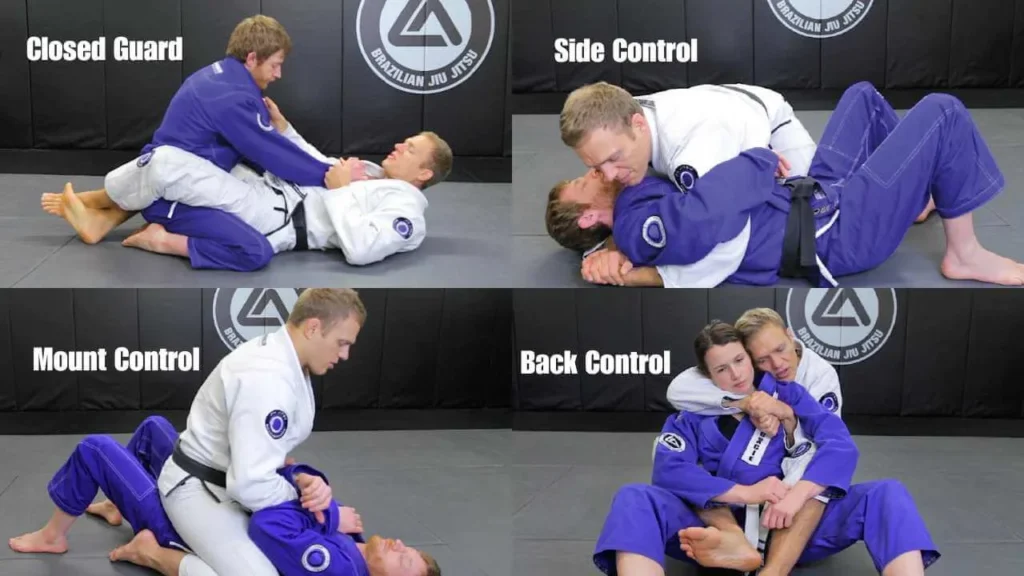
Positions are like different spots where you can control your opponent and defend yourself. The positions help you understand where you are strong and where you need to defend yourself. Some important positions you will learn include:
- Closed Guard (when you wrap the opponent’s legs around their back)
- Side control (where you are on the side of your opponent).
- Mount Control: (where you are on top of your opponent)
- Back control (where you control your opponent from behind, often with hooks and attacking their neck)
3. Transitions (Move from one position to another)
The third important thing you will learn as a BJJ white belt, first stripe is how to move from one position to another. This is called a transition.
For example, you might move from the guard position to the mount, or from side control to a stronger position.
Learning how to make these moves smoothly helps you stay in control during a roll (a practice fight).
4. Escapes (Getting out of bad positions)
Escapes are ways to get out of a bad position, like when someone is on top of you and holding you down.
As a white belt, you will learn how to escape from places like the mount or side control.
Learning escapes is important so you don’t stay stuck and can get back to a better position during a match.
5. Guard Passing
In Brazilian Jiu-Jitsu, the guard is a position where your opponent is on their back and uses their legs to block you or control your movement. This is a strong defensive position, and it can be hard to move forward if you don’t know what to do. That’s where guard passing comes in.
Guard passing means finding a way to safely move around or through your opponent’s legs to get to a better position like side control or mount.
Some important guard passing techniques include:
- Toreando pass (a pass where you use a quick movement to move around their legs).
- Knee slice pass (where you use your knee to slice through their legs and get to the side).

6. Sweeps
A sweep is when you’re on the bottom (like in guard) and you use technique to reverse the position and end up on top. Sweeps help you go from being in a defensive position to an attacking one. They are very useful because being on top gives you more control. The 2 most basic sweeps that you will learn are the scissor sweep and the hip bump sweep.
7. Submissions
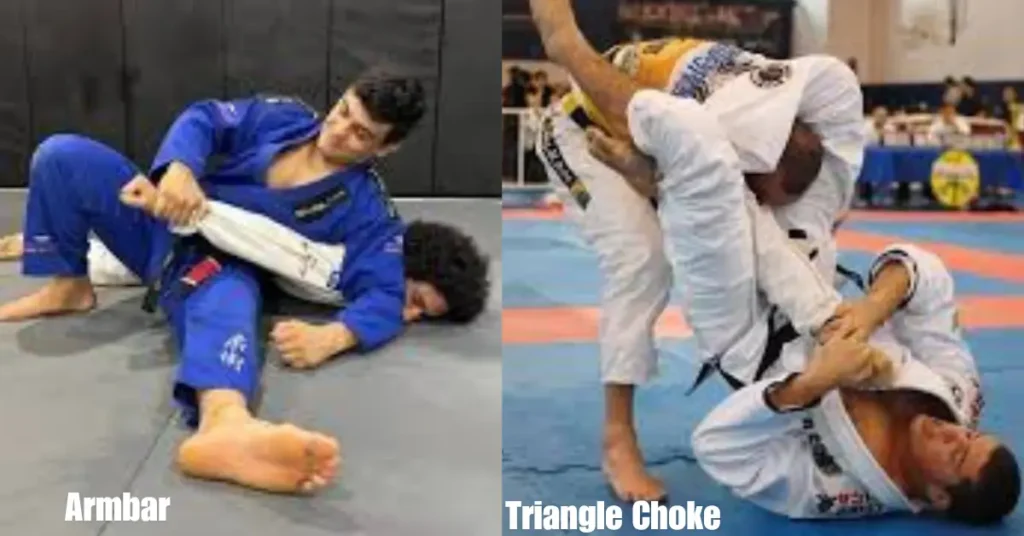
Submissions are moves where you can make your opponent give up by applying pressure to their joints or neck. At the 1st stripe level, you’ll start learning basic submissions, like Armbar (bending your opponent’s arm the wrong way) and Triangle Choke (applying pressure to the neck to make them tap out). Submissions allow you to finish a fight by forcing your opponent to quit.
BJJ White Belt Techniques – 2nd Stripe
Once you’ve earned your first stripe on your white belt, you continue to build your skills. The second stripe shows that you’re progressing and becoming more confident in the basics.
At this stage, you’ll improve what you’ve already learned and start working on more advanced techniques. Here’s what you’ll focus on for your 2nd stripe:
1. Positions
At this stage, you’ll focus on improving your control and understanding of positions. Some key positions you’ll work on are:
- Top positions like mount and side control (where you are on top of your opponent).
- Bottom positions like guard (when you’re on your back with your legs around your opponent)
- Half guard (when you’re on your back, but one of your opponent’s legs is trapped between yours).
2. Escapes
Escape is a skill that helps you get out of bad situations. At the second stripe level, you will improve your escape techniques. These escapes help you avoid getting stuck in a bad position and allow you to get back into a stronger position to fight. These include:
- Escaping from the mount (when your opponent is sitting on top of you).
- Escaping from side control (when your opponent is on the side of you, pinning you down).
- Escaping from back control (when your opponent has your back).
3. Guard Passing
At this level, you’ll improve your guard passing skills (such as knee slice or toreando pass). Guard passing is important because it helps you move past your opponent’s legs to get to a dominant position.
4. Sweeps
Sweeps are techniques that help you move from a bottom position to a top position. At the 2nd stripe, you’ll start learning more sweeps and working on them to improve your game. Some examples include:
- Scissor sweep (using your legs to create a scissor motion to move your opponent’s weight off balance).
- Hit sweep (using your legs to push and pull while shifting your body to change positions).
5. Submissions

At the 2nd stripe, you’ll start learning more submissions to finish a fight. Some basic submissions you may work on are:
- Armbar from guard (a submission where you extend your opponent’s arm and force them to tap out).
- Triangle choke (a choke where you use your legs to trap your opponent’s neck and cut off their breathing).
- Kimura Lock (a shoulder lock that puts pressure on your opponent’s arm). These submissions help you control your opponent and end a fight when you’re in the right position.
BJJ White Belt Techniques – 3rd Stripe
When you earn your third stripe on your white belt, it shows that you’re becoming more comfortable with the basics of BJJ.
At this stage, you are working on improving the techniques you’ve learned and gaining more confidence in your ability to control positions, transition smoothly, and apply submissions.
Here’s what you’ll focus on for your 3rd stripe:
1. Positions
By now, you should be more comfortable with basic positions. You’ll focus on refining your control and understanding how to move between them. Key positions you will work on are:
- Top positions like mount, side control, and north-south (where you are positioned with your opponent’s head near your chest).
- Bottom positions like guard, half guard, and back control (when your opponent has your back).
2. Transitions
Transitions are smooth movements that allow you to move from one position to another, depending on the situation. At the 3rd stripe, you will improve your ability to transition in and out of knee ride positions (where you are on top with one knee on your opponent’s chest or abdomen) and become more experienced moving in and out of half guard (when you are on your back but controlling one of your opponent’s legs).
3. Escapes
Escaping from bad positions is important, and at the 3rd stripe, you’ll work on becoming even better at escaping. Some escapes you’ll practice include:
- Escaping from Knee-on-Belly: This is when your opponent places their knee on your chest or stomach while controlling you from the top. You will learn how to escape this position by creating space and getting back to a better spot, like guard or side control.
- Triangle Defense: The triangle choke is a common submission that involves trapping your opponent’s legs around your neck, which can be dangerous in BJJ if not defended properly. Learning how to recognize the setup early and using effective techniques to avoid getting caught is key to staying safe during training.
4. Passing Guard
Guard passing is one of the most important skills in BJJ, and by the 3rd stripe, you should be improving your ability to pass your opponent’s guard. It will help you avoid being stuck in a defensive position and put you in control of the fight. You’ll work on:
- Knee slice pass (using your knee to slice through their legs and get to side control).
- Toreando pass (moving around your opponent’s legs by pushing their hips).
- Over-under pass (where you control their legs and pass under them).
5. Submissions
By the 3rd stripe, you’ll start learning and applying more advanced submissions. Some examples include:
- Armbar from mount (extending your opponent’s arm and forcing them to tap out).
- Triangle choke (using your legs to choke your opponent from guard).
- Americana (a shoulder lock that forces your opponent to tap out).
BJJ White Belt Techniques – 4th Stripe
The 4th stripe on your white belt is a sign that you’re progressing and becoming more comfortable with BJJ techniques. At this level, you’re starting to get deeper into the fundamentals and refining your skills. Here’s what you’ll focus on:
1. Positions
As you continue your journey, you’ll explore more positions that are useful in both offense and defense. Key positions you’ll focus on include:
- Turtle position: A defensive position where you’re on your knees and hands, trying to protect your back from being taken. It’s important to learn how to recover from this position and avoid being pinned.
- Scarf hold (Kesagatame): A top control position where you pin your opponent’s head and arm while controlling their body. This position is a good opportunity to transition to submissions or further control.
2. Transitions
Transitions are all about moving smoothly between positions to stay in control. At the 4th stripe, you’ll start refining your movement from one position to another, such as:
- Arm drag: A technique to move your opponent’s arm out of the way and create an opening for a takedown or a better position.
- Overhook and underhook game: You will begin to work on controlling your opponent’s arms by using overhooks (when your arm goes over theirs) and underhooks (when your arm goes under theirs) to set up sweeps or control transitions.
- Moving from turtle to back control: A crucial transition to improve your overall control and ability to dominate from different positions.
3. Passing Guard
Guard passing is one of the most important skills in BJJ, and at this stage, you’ll work on becoming more efficient with different guard passes:
- Standing guard passes: These involve getting up on your feet to break through your opponent’s guard and passing their legs to gain control.
- Breaking closed guard: You’ll learn how to open your opponent’s closed guard by using techniques that make it hard for them to maintain control of your upper body, setting up a pass.
4. Sweeps
Sweeps are essential for transitioning from bottom to top. At this level, you’ll start working on more advanced sweeps that require timing and technique:
- Kimura sweep: This sweep combines a submission with a movement to change positions. You’ll use the kimura lock to off-balance your opponent and then sweep them to the top position.
- Flower sweep: A sweep where you use your legs and hips to shift your opponent’s balance and bring them to the ground.
- Shotgun sweep: A dynamic sweep where you use your legs to push your opponent’s body while you pivot your own, moving into a dominant position.
5. Submissions
At the 4th stripe level, you’ll continue to refine your submission techniques, and start learning new submissions to control and finish fights:
- You’ll work on submissions from the scarf hold (kesagatme) position, such as arm locks or chokes, that can be applied from there.
- You’ll also start learning the Clock choke, a submission that involves using your opponent’s neck to choke them while you move around their head.
Want to know How to Earn Your Next Belt? Check our next article here ===*add link here====
Conclusion: A Short Overview of the Article
Earning stripes on your white belt in BJJ is a sign of progress and growth. With the first stripe, you learn the names and basic techniques. With the second stripe, you learn different skills like positions, escapes, sweeps, and submissions. By the third and fourth stripes, you are improving these skills. Once you complete all four stripes, your instructor will promote you to blue belt, usually within an average timeline of 3 to 6 months.
Remember, getting your stripes is a sign that you’re improving in BJJ. It’s not a race, everyone moves at their own pace. So, focus on the process of learning, enjoy the journey, and celebrate the small wins along the way. With dedication and practice, you’ll continue to grow as a BJJ student and achieve your goals.
How to Earn Your Next Belt: Moving from White Belt to Blue Belt
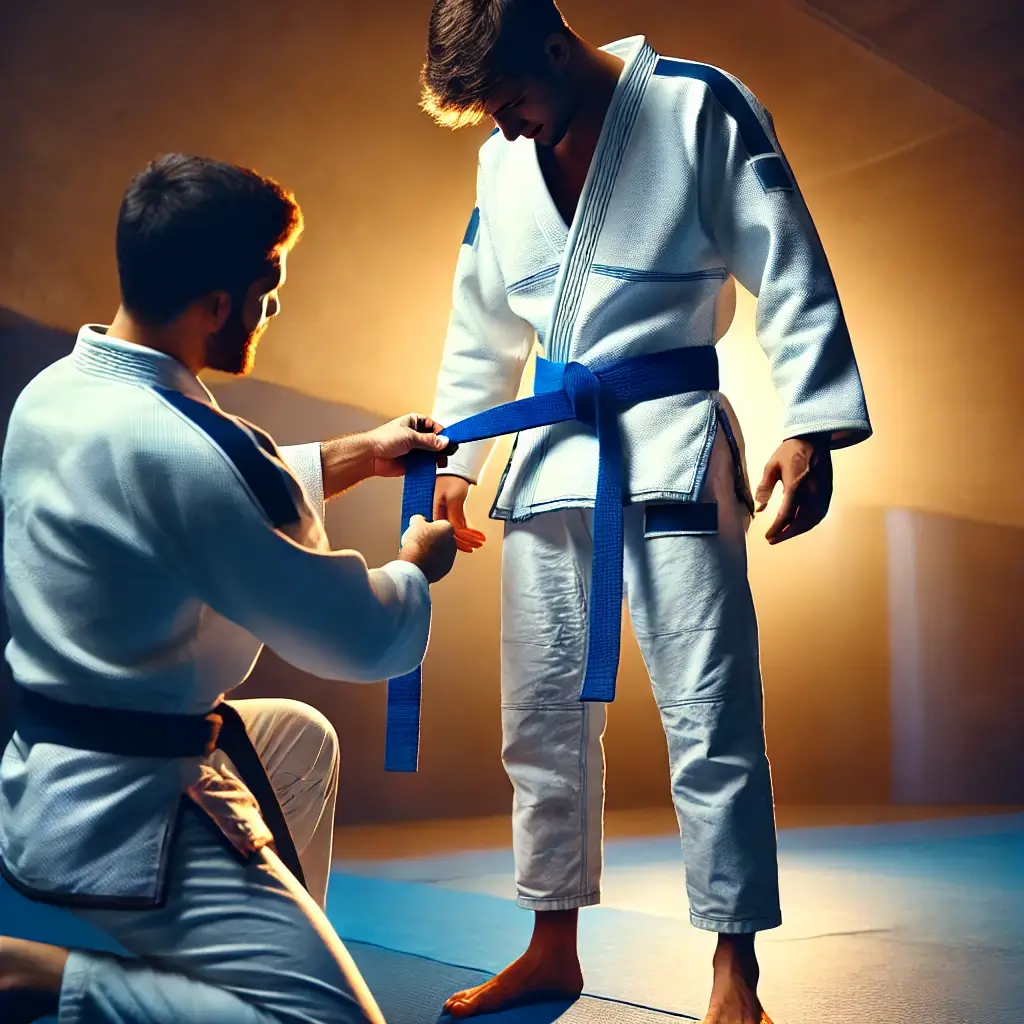
After earning your 4th stripe on your white belt, you’re getting very close to earning your blue belt in BJJ. But how do you move on to the next level? In BJJ, there isn’t a specific date when you can apply for your next belt. The key is training regularly, 3-5 times a week, and mastering the basics.
Your instructor will decide when you’re ready for the next belt. There’s no formal application process for promotion; your instructor promotes you when they believe you’re ready. On average, it might take 3 to 6 months after getting your 4 stripes to achieve this milestone!
BJJ Ranking System Journey From White to Red Belt.
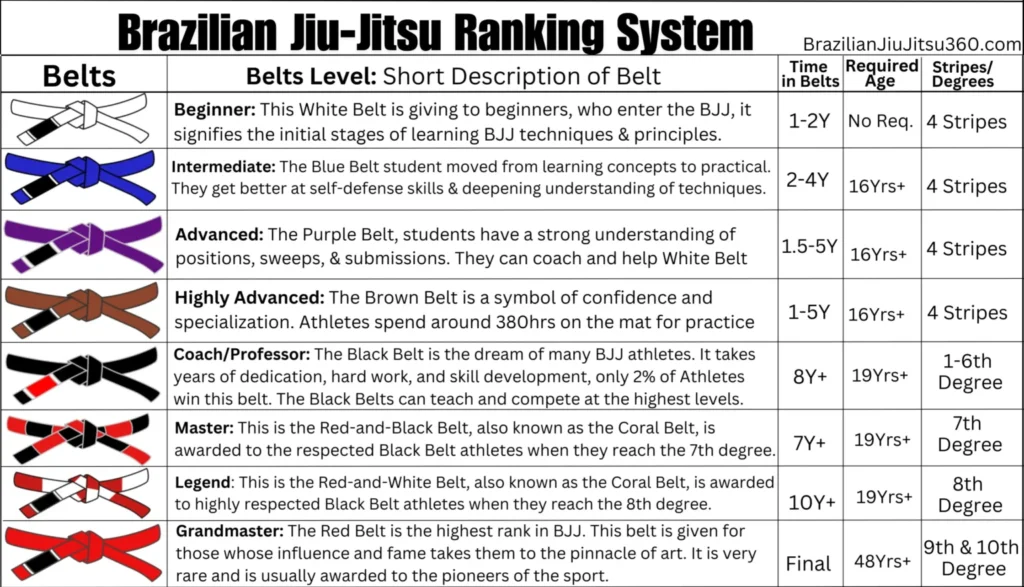
Conclusion: A Short Overview of the Article
Earning stripes on your white belt in BJJ is a sign of progress and growth. With the first stripe, you learn the names and basic techniques. With the second stripe, you learn different skills like positions, escapes, sweeps, and submissions. By the third and fourth stripes, you are improving these skills. Once you complete all four stripes, your instructor will promote you to blue belt, usually within an average timeline of 3 to 6 months.
Remember, every stripe you earn is not just about how fast you progress, but about building strong fundamentals and developing your skills in Brazilian Jiu-Jitsu. As you keep training and learning, you’ll be ready for the next level, eventually earning your blue belt and beyond.
Getting your stripes is a sign that you’re improving in BJJ. It’s not a race, everyone moves at their own pace. So, focus on the process of learning, enjoy the journey, and celebrate the small wins along the way. With dedication and practice, you’ll continue to grow as a BJJ student and achieve your goals.
FAQs
How Many BJJ Classes for First Stripe?
The number of BJJ classes required to earn the first stripe on a white belt varies depending on the school and instructor. However, on average, it typically takes about 20 to 30 classes or around 2 to 3 months of consistent training for a beginner to earn their first stripe.
In addition to class attendance, other factors like improvement in techniques, understanding of BJJ principles, and dedication to training are often considered before awarding a stripe. Some schools may also have specific requirements, such as demonstrating certain techniques or sparring skills. Be sure to check these requirements when you’re joining a BJJ gym.
What does a stripe on a white belt mean in BJJ?
In BJJ, a stripe on a white belt represents progress and improvement in a student’s skills. It’s a way for instructors to recognize smaller achievements as students work toward the next belt rank. Earning the 1st stripe means you’ve completed about 20% of your journey to the blue belt. The 2nd stripe indicates 40% completion, the 3rd stripe 60%, and the 4th stripe 80%. After earning all four stripes, and with 3 to 6 months of consistent training, students are usually ready to advance to the blue belt.
You May Like:

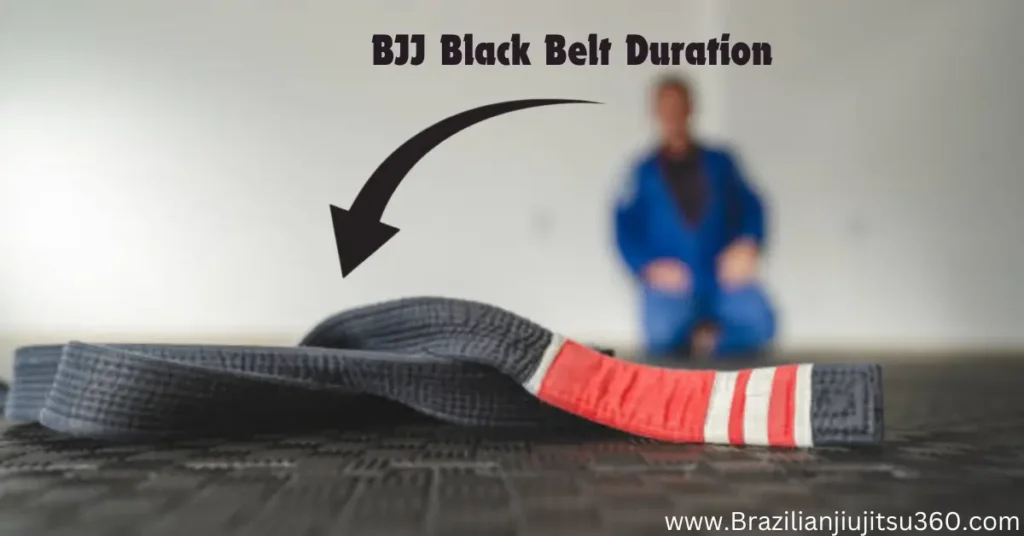
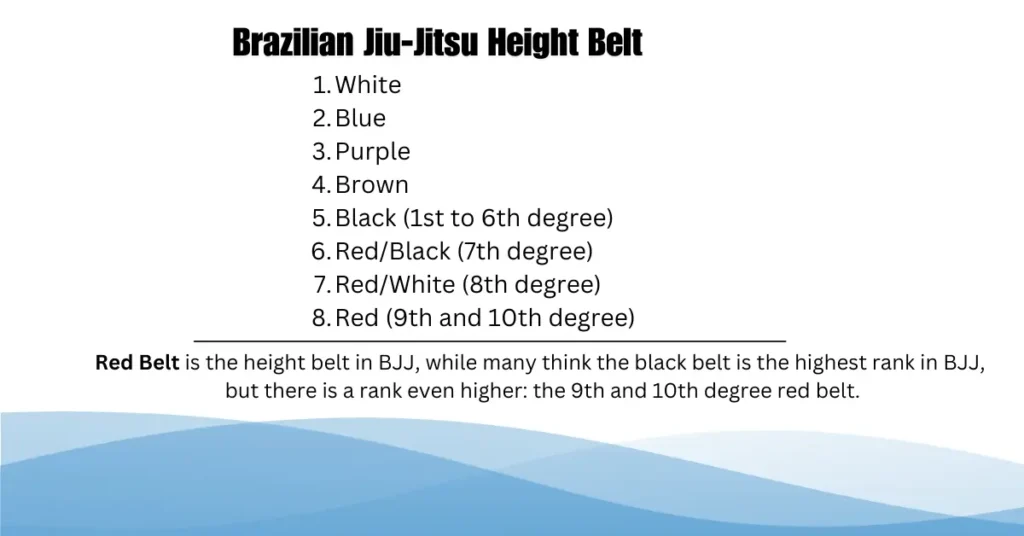

I am an SEO blogger and freelancer for the past 5 years. I don’t just write or work for bots like Google or Bing. My writing and other work, like SEO, design and more, are for real users who get real value from it. It is my responsibility to make sure that when a user comes looking for something, they get a complete answer to their query.


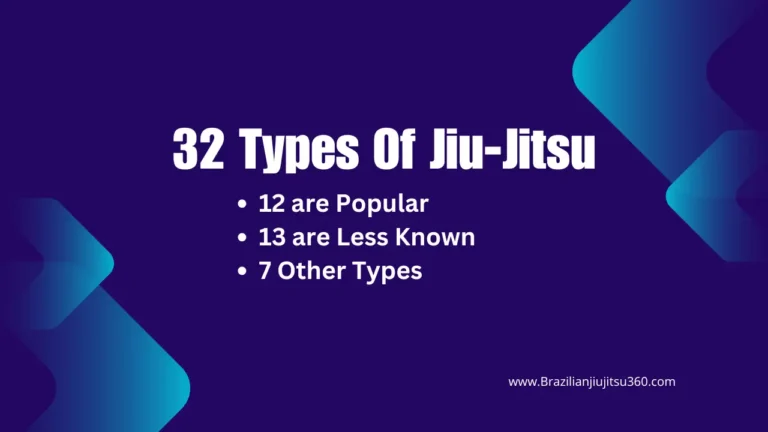
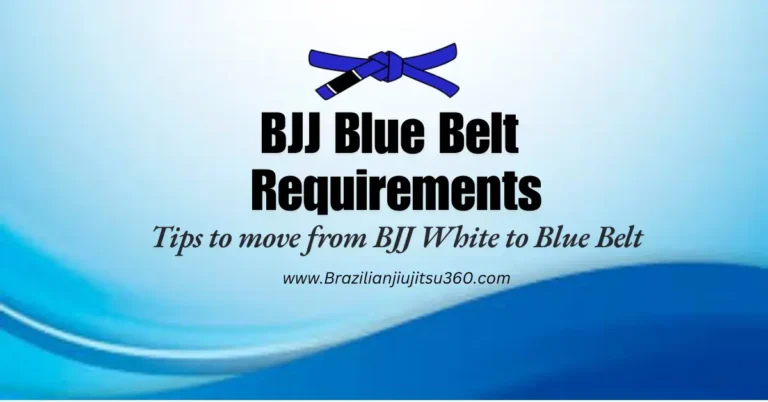

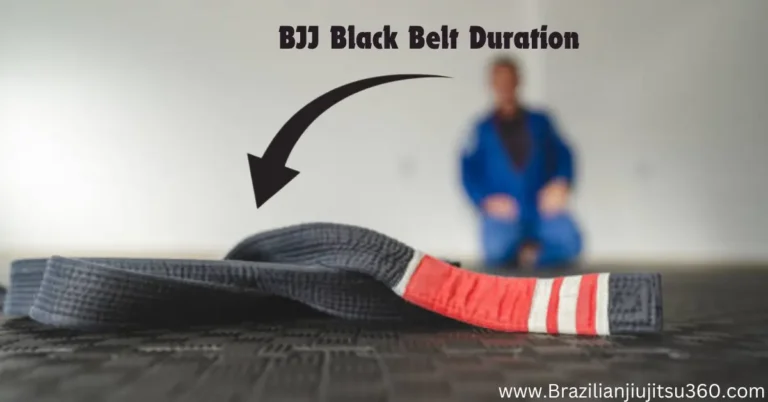


Excellent news for all us
[b]Present your wildness[/b] – [url=https://psee.io/663bfy][b]satisfy your sexual desire right now![/b][/url]
[b][url=https://bit.ly/3C6dEOb]XrumerAI – power of Xrumer + power of artificial intelligence![/url][/b]